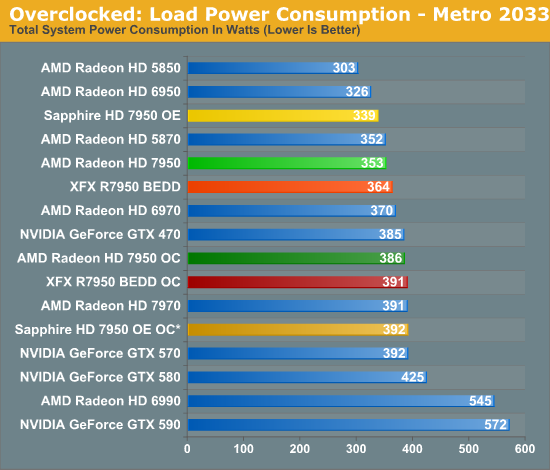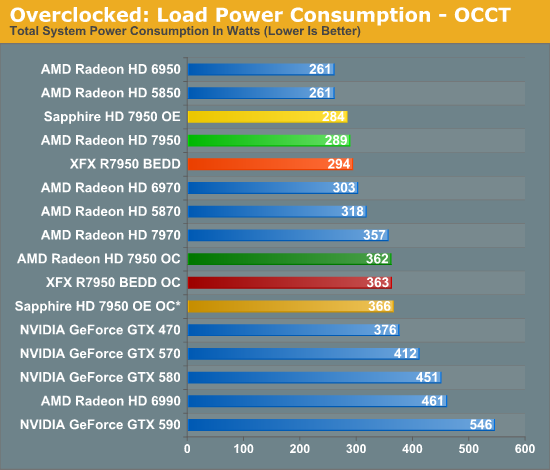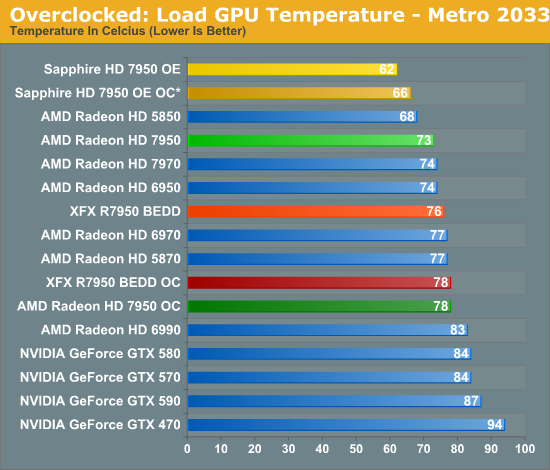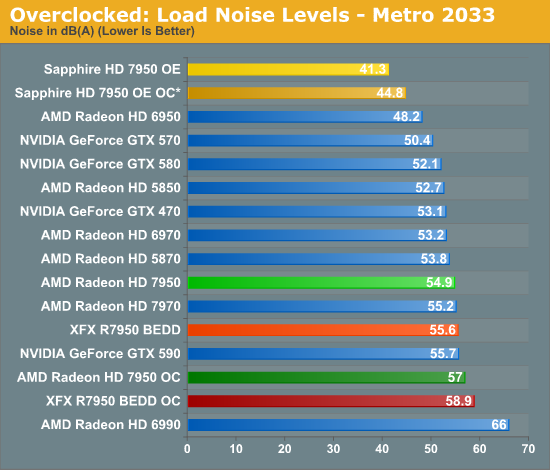AMD Radeon HD 7950 Review Feat. Sapphire & XFX: Sewing Up The High-End Market
by Ryan Smith on January 31, 2012 9:02 AM ESTOverclocking: Power, Temp, & Noise
In their marketing materials AMD is heavily pushing overclocking, and they have good reason to. With the 7970 we’ve established that Tahiti has quite a bit of overclocking headroom, and as the 7950 is clocked lower by default this opens up that headroom even further. Realistically AMD’s binning process means that the best clocking Tahiti GPUs are going to be allocated to the 7970 unless they have failed shaders, but even with that there’s quite a bit of potential on paper.
As with overclocking the 7970, our goal overclocking the 7950 is to see how much you can get for free; that is without any voltage adjustments. AMD’s reference PCBs are not particularly overbuilt for overclocking—cards like that will come later—so sticking to the reference voltage is the safest option, not to mention the easiest. With the 7970 we were able to get 200MHz (22%) overclocks without any voltage adjustment, and we’re hoping for the same out of the 7950.
With that said, we quickly ran into a wall on one card: the Sapphire 7950. Sapphire’s low VID of 0.993v may be great for temperature and noise at stock, but it’s not doing overclocking any favors. We only hit 950MHz at that voltage. As the Sapphire was the odd man out—every other card was at 1.093v—we did end up overvolting the Sapphire to 1.093v to see what it was capable of when put on similar footing as the rest of our cards.
After bringing up the voltage of our Sapphire card, all of our 7950s ended up overclocking to very similar levels. Our Sapphire and AMD cards topped out at 1025MHz core, a 225MHz (28%) overclock over a stock 7950 and a 125MHz (14%) overclock over the Sapphire’s factory overclock, while our XFX card reached 1050MHz, a 150MHz (17%) overclock beyond XFX’s factory overclock. Meanwhile the memory clocks on all of our cards topped out at 5.8GHz, beyond which we’d start seeing performance regressions from error correction on the memory bus.
| Radeon HD 7950 Overclocking | |||||
| AMD Radeon HD 7950 | Sapphire HD 7950 Overclock Edition | XFX R7950 BEDD | |||
| Shipping Core Clock | 800MHz | 900MHz | 900MHz | ||
| Shipping Memory Clock | 5GHz | 5GHz | 5.5GHz | ||
| Shipping Voltage | 1.093v | 0.993v | 1.093v | ||
| Overclock Core Clock | 1025MHz | 1025MHz | 1050MHz | ||
| Overclock Memory Clock | 5.8GHz | 5.8GHz | 5.8GHz | ||
| Overclock Voltage | 1.093v | 1.093v | 1.093v | ||
As you can imagine, with such similar overclocks, gaming performance on all 4 cards ended up being very similar. So we’ll get to gaming performance in a minute, while we’ll start with power, temperature, & noise.


Even though we’re not increasing the voltage on our AMD and XFX cards, merely overclocking them and raising the PowerTune limit to avoid throttling does drive the power consumption up. As is typical with heavily overclocked cards, overclocking quickly drives up power consumption and the 7950s are no exception. After overclocking power consumption is almost identical to the stock 7970, so while you can get 7970 performance you still need to pay the price with 7970 power consumption. Meanwhile it’s interesting to note that even with the extra 0.1v we’ve given the Sapphire card its final power consumption is only ever so slightly higher than the other 7950s, proving that voltage is the great equalizer in this case.


With the increase in power comes an increase in temperatures. The Sapphire card still does very well here staying in the low 70s even under OCCT, while the reference and XFX cards hit the high 70s under Metro and mid 80s under OCCT. As we’ve yet to really ascertain what the thermal limits are for Tahiti, it’s not clear whether there’s too much thermal headroom left for the GPU, particularly under OCCT.


Last but not least we have load noise. The Sapphire card is once more a stellar performer, and we still can’t get it above 50dB even with OCCT. Unfortunately the XFX 7950 BEDD has its biggest fallout yet—it may be able to overclock well, but at 64dB under OCCT the performance isn’t going to be worth the immense amount of noise it creates to move enough air to keep the GPU cool.










259 Comments
View All Comments
chizow - Thursday, February 2, 2012 - link
No the prices haven't dropped because there's no need to when the 7950 is about the same performance for the same price.As for basic economics, again, you're wrong.
Prices do fall without competition, look at the CPU industry. AMD STILL doesn't have a CPU that competes with the CPUs Intel was putting out 3 years ago.
Yet prices continue to fall, Intel continues to produce faster CPUs.
Why? Because Intel is competing with itself and its consumers need incentive to buy a new CPU. People will not pay the same price for the same speed processor, they demand innovation, progress. They also won't pay significantly more for marginal increases.
They expect more performance at the same prices, which is the same expectation as in the GPU market. Unless you're AMD and their fans I guess.
chizow - Thursday, February 2, 2012 - link
I didn't say anything about the 7970's stock levels, because unlike the 7950, it did actually sell out the 1st day. But there is actually a reason for someone to upgrade to it.The 7950? Not so much, not at that price anyways. If anyone wanted that performance it was there 14 months ago for the same price.
But yeah if you want to compare to past launches, you never saw stock of 5850/5870, 470/480, 570/580 for more than a few minutes at Newegg. Why? Because the performance was there for the asking price.
With these Tahiti cards at the prices and performance, its just lukewarm reception.
chizow - Thursday, February 2, 2012 - link
Nice try deflecting. Please retract your stupid statement about "price always reflecting performance", thanks. RV770 was obviously a price mistake that AMD has clearly tried to correct over the last 3-4 generations since evident by their ever-increasing prices. Either way, you're wrong.Not to mention the 3870 wasn't even the same generation. But yes that card wasn't high end because of its lackluster performance and the fact it was late. It was a refresh of the 2900 and was up against the 8800GT, another refresh part. Regardless, it was still AMD's highest performance single-ASIC SKU, so if it wasn't high-end that just means AMD had nothing worthy of high-end that generation.
Same may happen this round if this is all SI has to offer on 28nm. :(
chizow - Thursday, February 2, 2012 - link
Sure it is, because in this price range, the only people who would be interested in buying it are the people looking to upgrade who have already spent this amount.Sure there's going to be a few first time buyers who may pick this card up and it makes some sense, but this card isn't going to be a worthwhile upgrade for the vast majority of buyers who already have something from the last few generations.
They expect more, simply put.
chizow - Thursday, February 2, 2012 - link
Sure they can, its called projecting or forecasting. It would be negligent of them to ignore what Nvidia has to offer, and similar for Nvidia. Given they share the same fab its obvious neither have a technology advantage, so you have to target your competitor's product using that same technology. Anything less would be irresponsible.chizow - Thursday, February 2, 2012 - link
Rarson, maybe we need to take a step back. You keep insisting I don't understand how this market works, or how pricing is supposed to work. Maybe you can explain how YOU think it works.Let's start off with the basics:
What do you think drives price in the GPU market?
What do you think dictates a particular price:performance metric?
Do you think these two variables continue to scale linearly to infinity as one or the other increases?
What do you think resets this price:performance metric, if at all?
If you can start by answering these questions, and then go back and try to reconcile historical price:performance data points going back to say, the 8800GTX that'd be great.
Thanks!
chizow - Thursday, February 2, 2012 - link
Translation: "I have really low expectations when it comes to GPUs on a new process/technology/architecture"So Sick - Friday, February 3, 2012 - link
CHizzo you talk about a pricing error from AMD but you know what was a the absolute least flattering act in history of the gpu?
When AMD released their Radeon 9700 pro the 5800 ultra from nv stumbled caused by an error making it incapable of running aa correctly...after that the ultimate chaos ever shown in history of hardware was spread by your beloved green hope crew. They had a communication crisis resulting in 3 different versions of their nv40 on different departments without knowing this from each other...in other words the cooperation with their own green colleagues died for a moment and time stood still. Ever since that shameful fact Nvidia is passing AMD..A lot of time they only clzaim they will be fatser in the future like they do now...thank you nv for the green hope in these dark times.....
chizzo take your shizzle talk and stop making a fool of urself please
So Sick - Friday, February 3, 2012 - link
http://nl.hardware.info/reviews/2528/22/amd-radeon...in the vid you see how 3d11 has these results:
7950oc P11392
580oc: P7500? at most...
Boushh - Friday, February 3, 2012 - link
I don't mean to rain on your parade.But when a new product is released, the most obviouse thing to do is to price it at the same level as the highest product from the competitor. Thus AMD should have priced the 7970 around the same amount as the 580.
By doing this you put the pressure on the competitor. You also make sure people choose your product because it is the same price as that of the competitor, but faster, beter, etc.
It's the same what happend just before the release of the Core architecture by Intel. AMD knew that the Core CPU's where much faster, and didn't have anything to compete. Instead of cutting the prices early and gain market share, they waited untill after the last posiible moment to lower their prices.
Sure, the made a dollar or 2, but at what price ?
Once you have the advantage on your competitor, you should use it anyway possible to harm your competitor.
And AMD has the advantage, but they fail to make any use of it at the moment.
Which gives the impresion they don't care about there market share, or if Nvidia would be forced to lower the prices of their products before they wanted to, or if Nvidia will be forced to release there products before they are ready.
But obviously you don't care about that..